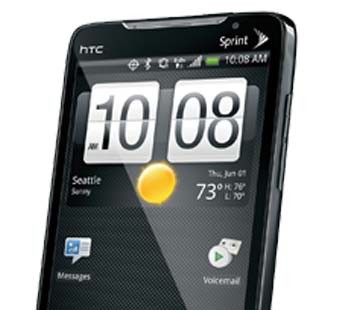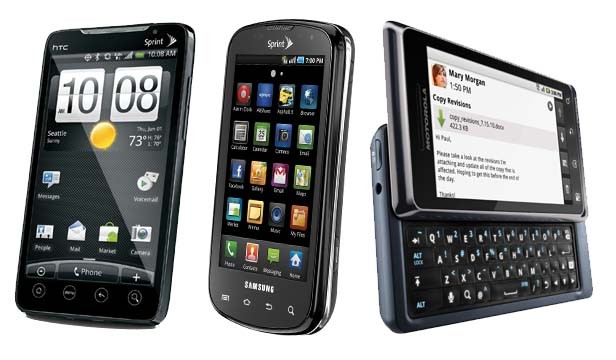Do you remember the last time you used your phone to actually make or take a call? All kidding aside, the truth of the matter is that today we rely on our phones more and more for web browsing, e-mailing, GPS, shooting photos and video, tweeting or doing any number of things that there’s an app for. But not to fear, device manufacturers and software developers are responding to our growing number of mobile needs with devices, operating systems and apps that are faster and more powerful than ever. If you’re giving the gift of communication this year, read on to find the right device for everyone on your list.
Android smartphones
Android phones are tailor-made for the Google devotee. The operating system, which is developed by the web giant, features an arsenal of built-in Google services, including Google Search, Gmail, Google Maps (with Place and Navigation), YouTube, Google Talk and Google Earth. Android is the leading OS on the market, accounting for one-third of all smartphones sold in the U.S. market, according to NPD Group, a market research company. The Android Market currently features more than 70,000 apps.
Sprint HTC Evo (Sprint)
The first 4G phone, the EVO is a monster, touting a 4.3-inch 480x800-pixel display. There’s a 1.3-megapixel front-facing camera for video chat or, for the Facebook-prone, self-shot profile pics, and the backside camera captures both 8-megapixel photos and 720p high-def video, which you can play right to your TV via the Evo’s HDMI out port. A 1GHz processor provides speedy browsing and e-mailing on either 4G, 3G or Wi-Fi networks. The microSD slot comes standard with 8GB chip, and memory can be expanded to 32GB. The Evo can be turned into a hotspot to support other wireless devices, and it even features a kickstand for viewing high-def media in widescreen mode.
Price: $199.99 with two-year contract
Samsung Epic
Like the Evo, the Epic is a 3G/4G phone that doubles as a Wi-Fi hotspot (supporting up to five devices). The 4-inch Super AMOLED screen features a virtual Swype keyboard and also slides out to unveil a full QWERTY keyboard for those who prefer actual buttons to text and e-mail. The 5-megapixel camera/camcorder features autofocus, a Power LED flash and a 3x digital zoom for capturing 720p high-def video at 30fps; a front-facing VGA camera allows for video chat. The 1GHz processor powers apps and browsing, and the Epic comes with a 16GB microSD chip standard, expandable to 32GB.
Price: $249.99 with two-year contract
Verizon Motorola Droid 2
Just like the original Droid, the Droid 2 is a slider, but beyond that there aren’t a whole lot of similarities. The Droid Deuce offers a battery usage life of 575 minutes, a nearly 50 percent increase over the original. It comes stock with Android 2.2 Froyo and Adobe Flash Player 10.1, and it features 8GB of on-board memory in addition to an 8GB miroSD card (expandable to 32GB). The 5GB camera/camcorder records DVD-quality 720x480 video at 30fps. The Droid 2, which runs on a 1 GHz processor, can support up to five devices as a Wi-Fi hotspot. “Star Wars” fans can show their enthusiasm with a special namesake R2-D2 version, the backside of which is designed after the famous robot.
Price: $199.99 with two-year contract
Motorola Droid X
The Droid X shuns the slider for a candy bar body of more Evo proportions. It features a 4.3-inch 854x480-pixel high-res screen to display its 8-megapixel photos or 720p (1280x720) high-def video, which also can be displayed on a high-def display via the HDMI out at up to 30fps playback. As is becoming expected of smartphones, the Droid X can function as a Wi-Fi hotspot for up to five other devices. The Droid X packs a 1Ghz processor, up to 8GB on-board memory and a pre-installed 16GB microSD card, expandable to 32GB.
Price: $199.99 with two-year contract
T-Mobile HTC G2 with Google
The sequel to the first Android phone, T-Mobile’s G1, the G2 is T-Mobile’s first 4G-capable phone. The G2 runs Android 2.2 on an 800MHz processor, and the 3.7-inch 480x800-pixel Swype-enabled touch screen slides out to a full QWERTY keyboard. The 5-megapixel camera features flash and autofocus and also captures 720p HD video. The G2 comes with 4GB of onboard memory and an 8GB microSD card comes standard (with support for up to 32GB). Users also can control their phone – make calls, send messages, browse the web – with the new Google Voice Actions feature.
Price: Price TBD
iOS
Apple’s operating system is no stranger, as it powers iPhones, iPod Touches and iPads, and is prominently displayed in the ubiquitous television commercials for each. The latest version of the software, iOS 4, brings multitasking to the iPhone, introduces a new video-calling feature called FaceTime, and, of course, offers direct access to music and movies via iTunes and the more than 250,000 apps available in Apple’s App Store.
AT&T iPhone 4
Forget the infamous antenna issues for a moment and focus on what makes this the best iPhone yet. The 3.5-inch touch screen features what Apple is labeling Retina Display – 640x960-pixel resolution at 326 ppi. The LED flash camera/video recorder captures 5-megapixel stills and 720p video up to 30fps. The iPhone 4, available in 16GB or 32GB models, features a much-improved battery life over previous models and also introduces a three-axis gyroscope along its accelerometer for improved gaming
Price: 16GB – $199 with two-year contract. 32GB – $299 with two-year contract
webOS smartphones
Palm’s operating system for its Pre and Pixi devices is all about consolidation. Users can feed multiple e-mail accounts into a single inbox, and Palm Synergy integration brings together multiple sources of information (think Facebook, Google and LinkedIn) into one space for both contacts and calendar events. The announced 2.0 version of webOS will organize multitasking programs into like groups under a feature called Stacks, and Synergy will open to developers to integrate account and contact information and events right into new apps, thousands of which, from Fandango to Facebook, are available in the Palm App Catalog.
AT&T / Verizon Palm Pre Plus
The touchstone design features a 3.1-inch multitouch screen that slides out to a full QWERTY keyboard. The camera captures video and 3-megapixel stills with LED flash. Wi-Fi capability also serves as a hotspot for up to five devices (Verizon only). The Pre Plus features 16GB of memory and comes with built-in GPS.
Price: AT&T – $149,99 with two-year contract. Verizon – $49.99 with two-year contract
Palm Pixi Plus
This candy bar smartphone features a 2.63-inch touch screen alongside a physical QWERTY keyboard – no sliding required – and comes with 8GB of memory. Like the Pre Plus, the Pixi Plus has W-Fi hotspot capabilities (Verizon only) and built-in GPS, while the LED flash camera captures 2-megapixel stills, plus video.
Price: AT&T – $79,99 with two-year contract. Verizon – $29,99 with two-year contract
BlackBerry smartphones
Customizable menus and Home screen, universal search, an all-in-one social network feed and faster web browsing (including tabs) are among the upgrades in the BlackBerry 6, the newest operating system. System-wide multitouch means tasks are only a few simple touches away (versus reliance on the menu button) and a new Wi-Fi media sync feature lets you view your MP3 library, tweak playlists and download songs right over the same wireless network. The new OS will push to the BlackBerry Bold 9700 and 9650, and the BlackBerry Pearl 3G, but it’s standard on the new Torch 9800 handset (and, of course, future BlackBerry devices).
AT&T – BlackBerry Torch 9800
The newest BlackBerry features a 3.2-inch touch screen and is slightly larger than a credit card when closed, but it slides open to reveal a full QWERTY keyboard for tapping out e-mails on the go. The 5-megapixel camera features zoom, autofocus, image stabilization and 11 screen modes, in addition to video recording. The Wi-Fi-ready Torch can sync media files over wireless networks and is capable of tethering other devices. A 4GB media card is included, and it supports microSD cards up to 32GB. Price: $199.99 with two-year contract























